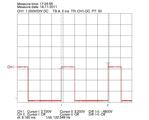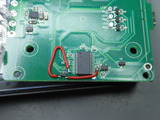
| [ Main index » Bicycle components tests » (Dynamo) bicycle lighting » Philips LED bike light review » Philips LBL modification | Dutch: Deze pagina in het Nederlands ] |
Norman Hurkens measured and modified with the following results:
LBL manufacturing date 0911, batteries are 2700mAh:
Mode: off: I-LED = 0A ucontr. pin 11 = low ucontr. pin 13 = low Mode: eco: I-LED = 0.2A ucontr. pin 11 = high ucontr. pin 13 = 120Hz dutycycle 29% runtime: 6 h
Mode: high: I-LED = 0.7A, then 0.2A (when switched back to eco) ucontr. pin 11 = high ucontr. pin 13 = high (dutycycle 100%) runtime: 85 min high, then 112 min eco
To do the following modifications you need to remove the battery holder as the relevant electronics is on the reverse side of the PCB. To do this use a sharp hobby knife or small grinding tool for the plastic, then desolder the battery holder.
Pin 13 is the control for the LED driver.
1st modification: Control the LED driver via pin 11 instead of pin 13. This gives full power in eco and in high with 0.70A LED current. Runtime = 113 minutes. Everything works except eco mode, charging works fine. (How well/bad do the status LEDs work in showing you battery capacity?)
2nd modification: Use pin 13 as input to an npn transistor which is used as an inverter, fed with pin 11 via a resistor. The inverted signal then goes to the LED driver. This gives a dutycycle of 71%, with an average current through the LED of 0.71*0.7A = 0.52A. Theoretical: Runtime should become (113/0.52)*0.7A = 152 minutes, so 2.5 h.

Experiences: You can't put the lamp in high mode, light goes off then because the inverse of 1 is 0 (only the blue status LEDs on top are lit). Charging goes fine. The blue LEDs on top don't give a great indication of battery charge: the 2nd LED is off after 2:15 and the last LED starts blinking 10 minutes after that which only last another 5 minutes, and the lamp switches off...
| To email me go to the email page |
Last modified: Tue Dec 4 00:41:55 CET 2012